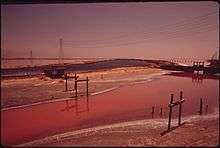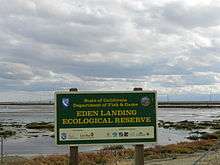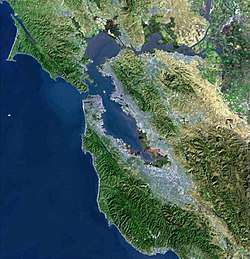San Francisco Bay Salt Ponds
The San Francisco Bay Salt Ponds are an approximately 16,500-acre (6,700 ha) part of the San Francisco Bay that have been used as salt evaporation ponds since the California Gold Rush era. Most of the ponds were once wetlands in the cities of Redwood City, Newark, Hayward and other parts of the bay.
.jpg)
Salt production goes back to when the Ohlone were the only people in the area. After the large influx of people to the area in the 1850s, industrial production began. At first, production was predominantly small family operations, but over time these were replaced by companies like the Oliver Salt Company in Mount Eden and Leslie Salt in Newark. Eventually, Cargill bought out the companies to become the dominant producer in the area. Since 2003, there has been a move to close the ponds and return the area to its natural state. This process may take as long as thirty years.
Geography and fauna
On the West Coast, the San Francisco Bay is one of two areas with the natural conditions from the sun and wind needed to allow for salt extraction from sea salt to be a commercially viable operation.[1]
The ponds are noted for their vivid colors, ranging from magenta to blue-green, that are especially visible from the air. The colors come from the brine shrimp and microorganisms that thrive in the different salinity levels in the ponds. In particular, synechococcus, halobacteria, and dunaliella affect the color of salt ponds.[2]
History

At the time of the Gold Rush, salt was an important part of food preservation and was used in many industries. The favorable conditions and the immediate need sparked the explosion in salt production.[3]
At the time, the marshlands were seen as unproductive land that could be developed for better uses. Eventually this led to 80% of the original marshes developed for other uses.[3] Over time, many of the smaller producers sold their land and producing rights to the Oliver Salt Company,[4] which would eventually replace the Leslie Salt Company in Newark. In 1972, Cargill purchased Leslie to become the dominant landholder and holder of salt production rights in the area.[5]
In 2003, Cargill sold the bulk of its salt ponds to the California Coastal Conservancy, the United States Fish and Wildlife Service, and private foundations with the goal of restoring the ponds to wetlands. This effort is known as the "South Bay Salt Pond Restoration Project".[6][7]
Not all the salt ponds are being restored. Cargill has proposed development of the ponds into housing in Redwood City.[8]
South Bay Salt Pond Restoration Project

The project is being headed by the state of California and the federal government to restore 15,100 acres (61 km2) of Cargill's former salt ponds in San Francisco Bay.[9] In October 2000, Cargill proposed to consolidate its operations and sell lands and salt production rights on 61% of its South Bay Operation area. Negotiations were headed by Senator Dianne Feinstein and a framework agreement was signed in May 2002 by the conservancy, the California Resources Agency, the Wildlife Conservation Board, the California Department of Fish and Game, United States Fish and Wildlife Service, Cargill and Senator Feinstein.[9] California approved purchase of the property on February 11, 2003. The land is currently managed and owned by the US Fish and Wildlife Services and the Department of Fish and Game.[9] The goal of the South Bay Salt Pond Restoration Project is to restore 90% of the former salt ponds to natural wetlands. The Native Plant Nursery at Don Edwards San Francisco Bay National Wildlife Refuge is providing plants to the restoration project. The SBSPRP, with over 15,000 acres and a 50-year plan, is the largest wetlands restoration project on the West Coast and provides the benefits of wetland restoration, including flood control, pollution reduction, habitat expansion for wildlife, and public access and recreation for people.[10]
The South Bay Salt Pond Restoration Project is integrating restoration with flood management, while also providing for public access and wildlife-oriented recreation and education opportunities.[9] Restored tidal marshes will provide critical habitat for the endangered California clapper rail and the salt marsh harvest mouse. Large marsh areas will also provide extensive channel systems which will provide habitat for aquatic life and harbor seals.[9] Flood management will also be integrated to protect local communities. Restoration will also offer many opportunities for public use, including trails for hiking and biking, hunting, bird watching, environmental education and other recreational opportunities.[9]
Eden Landing Ecological Reserve is part of the area being restored. The Hewlett Foundation has funded restoration of the Bay Area Salt Ponds.[11]
References
- Lou Ann Speulda-Drews; Nicholas Valentine (March 9, 2009). "Appendix E: Identification and Evaluation of the South San Francisco Solar Salt Industry Landscape" (PDF). South Bay Salt Pond Restoration Project. United States Fish and Wildlife Service. Retrieved May 2, 2015.
On the West Coast, only San Francisco Bay and San Diego Bay possess the exact conditions to allow the industry to thrive. In order for the solar salt industry to flourish several natural features need to occur: a protected bay; large expanses of flat, shallow water shoreline; abundant salt water; months of dry, sunny weather; and periods of rain.
- "Solar Sea Salt Ponds". Cargill.
- Sommer, Lauren (December 14, 2017). "What Are Those Weird, Pink Ponds in San Francisco Bay?". KQED.
- "Mt. Eden Salt Industry: Oliver Salt Company - Digital History". eastbaydigitalhistory.wikidot.com.
- "Leslie Salt". Schilling Family of companies website.
- "San Francisco Bay Salt Ponds". Cargill.
- "Salt Ponds of San Francisco Bay". Atlas Obscura.
- Eslinger, Bonnie (December 8, 2012). "Redwood City Saltworks project waits in limbo while feds mull next course". San Jose Mercury News.
- "South Bay Salt Pond Restoration Project". Retrieved September 21, 2012.
- South Bay Salt Pond Restoration Project. (Pamphlet). California. 2009.
- "Historic Agreement Reached to Purchase San Francisco Bay Salt Ponds". South Bay Salt Pond Restoration Project. May 29, 2002. Retrieved February 21, 2019.
External links
| Wikimedia Commons has media related to San Francisco Bay Salt Ponds. |
- "Archimedes Screw Pump, Leslie Salt, Newark". Center for Creative Photography. The University of Arizona.
- "South Bay Salt Pond Restoration Project".
- Johnston, Angela (April 4, 2019). "The Bay's colorful salt ponds are fading, and that's a good thing". KALW.
